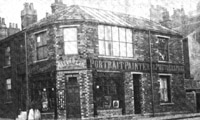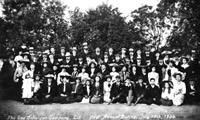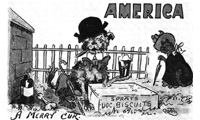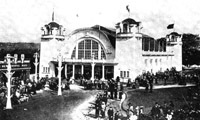Alfred Coe, Postcard Pioneer
Graham Hall
(First published in 1991 in volume 5, pp. 71-77, of the third series of The Bradford Antiquary, the journal of the Bradford Historical and Antiquarian Society.)
Being a fanatical postcard collector, especially of local material, aroused my curiosity concerning local postcard manufacturers and encouraged me to carry out some spare time research into them. This led me to Walter Scott, one of the most prolific and well known, and also to Alfred Coe. It was Mr Coe and his work which set me off on this trail of discovery.
During the early years of this century picture postcards were to some extent a fashion, a fad, but nevertheless an important industry employing large numbers of people in their production. They were also a vital means of communication - a point almost forgotten today. It was the age before radio and the telephone still had not grown beyond its adolescent stage. Postcards addressed to local destinations sent in a morning would be delivered during the afternoon of the same day.
Printers and photographers alike realised the huge commercial potential and the two often combined to produce a staggering variety of postcards, difficult to comprehend today. An enormous quantity of cards dating from before the onset of the First World War are fortunately still with us. They give an insight into an era never before possible, something of a 'window on the past'.
Alfred Coe was born at Undercliffe on 12 February 1851. He was the son of Bridget and John Coe, whose occupation is given as clothier on Alfred's birth certificate. As yet we have no information about the early life of Alfred, and only one clue has come to light concerning his original occupation. His trade is listed on the birth certificate of his third child born in 1879 as warp twister. Alfred married Mary Rushforth, whose family is believed to have hailed from the Kendal and Carlisle regions, in about 1872. Alfred and Mary had four children; Clara, Albert, Violet and Emily born between 1874 and 1881.
Alfred appears to have become interested in photography through members of his wife's family: there were Rushforths established as photographers in Barnsley by the early 1870s. How early in his life this interest began is not known but he may eventually have served some form of apprenticeship to the trade with the well known Bradford photographers, Albert Sachs. Evidence is only slight on this point and far from conclusive.
At this time the Coe family resided at 27 Walnut Street, Leeds Road but by 1885 Alfred ventured into business as a photographer and the family moved to 10 Fearnley Street, Otley Road. In trade directories of the period this was also given as Alfred's business address. The family moved several times within a very short period; in 1887 they resided at 224 Otley Road. then 123 Peckover Street in 1888, 6 Stott Hill in 1892 and 32 Church Bank in 1895. The photographic business appears to have thrived during this period and eventually found a more permanent address at 2 Barkerend Road where it appears to have remained for almost twenty years. The family's last known home address seems to have been Hillside Villas where they moved in 1903.
When Alfred Coe ventured into producing and printing postcards is not precisely known but he was certainly deeply involved in collotype printing by the middle 1890s. It seems that he formed the Coe Collotype Company during the early 1890s and ran it entirely separate from his photographic business. The process of collotype printing was extensively used on the production of view postcards around the turn of the century; it, reproduced exactly the original photographic image on to ordinary printing paper. The process is derived from the application of photography to lithographic printing and was first developed in France around 1865.
Alfred must have been keenly interested in this process from the start and used his skills to develop it further. The discovery of two detailed patents, one dated 23 January 1899 and the other 25 April 1902, prove this beyond doubt. Whether these patents resulted in financial gains is not known.
The first postcards to appear produced by the Coe Collotype Company were probably from around the time of the first patent. In 1901 the company occupied premises at 13 Chapel Street, Leeds Road and like many postcard manufacturers of the period they developed rapidly By the following year they had moved to larger premises at 44 Vicar Lane where they employed over forty people. An extract from The Stationer & Printer trade journal for March 1904 gives the following information: 'Inventors of Coe Collotype Printing Machine. Floor space at their premises has trebled recently, and fourth time in four years that premises have been extended. They have also moved three times.'
Initially their work consisted mainly of local views, one of the earliest series being 'The Old Bradford Series'. At least sixty cards are known to have been issued, many untitled and they are certainly not numbered, making it extremely difficult to know precisely how many different cards were produced. The set first appeared in late 1902 or early 1903 and they show fine sepia reproductions of the well known series of water colour paintings by N.S. Crichton and Arthur North showing Bradford and its many characters during the latter part of the 19th century.
The company does not appear to have produced cards for sale nationwide but several examples have come to light which demonstrate only too well that Alfred often ventured far from the boundary of Bradford. View cards have been discovered depicting places as far apart as Blaenau Festiniog and Morecambe. Even foreign views were issued which are believed to have come from photographs he took during at least one overseas holiday. An undated and untitled family album of Alfred's contains views of Gibraltar and France.
Alfred was certainly a man of imagination and humour. He ventured into producing many comic cards, including a whole series issued at the time of the Boer War entitled 'South African Fashion Plates'. There were also others which went under such titles as 'The Continental Series' and 'The Publication Series'. Each card was a pun on words, for instance in the former we get 'America - A-Merry-Cur': the card shows a dog with a bowler hat, cane bow tie and a glass of beer!. Also, 'Australia -Hos-Trail-Yur?': again we see a man being pulled on a rope behind a horse being dragged through a cactus!
The Coe Collotype Company undoubtedly reached its zenith in 1904. In that year they were awarded a bronze medal at the International Printing, Stationery & Allied Trades Exhibition held in London. Wording on the medallion reads 'Awarded to the Coe Collotype Co. Bradford, for collotype postcards'.
1904 also saw the opening of the Bradford Exhibition, an event of international scale which produced a flood of souvenir postcards. The majority. but not all, were produced locally and the Coe Collotype Company probably issued more than any other company They ranged from pre-exhibition issues which were on sale before the event opened to yet again comic cards. Some of the hundreds of cards produced by Alfred's company were carefully numbered so we can gain some idea of the vast number they manufactured. Perhaps the most fascinating were a now scarce series of midget postcards. about the size of half a standard card: such novelties were popular at the time. This unusual series was rarely titled, therefore making it difficult to identify today. Twenty one have been discovered to date, all from local sources which seems to point to the fact that they were probably not sold in large quantities.
Recent evidence shows that Alfred Coe's photographic business went into liquidation by at least November 1905. Whether the collotype printing section suffered the same fate is not known. Following this there is evidence that Alfred may have gone into partnership for a short time, as in the 1906 Post Office Directory we find a Coe and Beaumont listed at 7 Little Horton Lane. It seems more than a coincidence that these premises were occupied from as early as 1861 by Appleton & Co., probably the most famous of all local Victorian photographers.
Another strange link in our story is that Charles Judson, Emily Coe's husband, is also listed as a photographer at the same address. Mr Judson became head of the art department at the Bradford Telegraph & Argus but we know nothing of his activities as a photographer. The link with the Appleton concern is perhaps more than coincidental: the Appletons were close friends and amongst the extensive collection of Alfred's family photographs we find a carefully titled portrait of a small boy aged about ten. The boy was to gain eminence in another direction entirely, for the titling, done by Alfred's daughter some years after the photograph was taken, tells us that the boy is Sir Edward Appleton, the scientist but at the time just another member of the family, no doubt well known to Alfred.
Facts concerning other aspects of the business elude us but two personal tragedies in Alfred's life perhaps give a clue to what happened. On 13 April 1901 Albert, his only son, died at the tragically early age of twenty five. We know little about this young man, he was artistically gifted like his father and spent some time at art school but whether or not he helped Alfred in the business is not known. Five years later Alfred's wife, Mary died on 25 October 1906.
The impression gained from this is that Alfred had had enough and quite possibly his thriving business suffered. Not long after his wife had passed away he decided to emigrate to the United States with his eldest unmarried daughter, Clara. They lived in Florida and the Catskill Mountains regions for a time and Alfred seems to have been content to spend a quiet undisturbed retirement. Sadly on 5 November 1917 he was struck by a car whilst out walking in Mount Vernon, New York State, where he lived at the time - a tragic end to a gifted man.
What became of Alfred's three surviving daughters? Clara, who had emigrated to America with him. spent the rest of her life there. Emily, the youngest of Alfred's children had no connection with the business, even though she was certainly artistically gifted like most the family More is known about Violet than any of Alfred's other children. She became involved with Alfred's photographic business and helped with the developing process - she often complained about the chemicals affecting her skin. It is quite possible many of the photographs were actually taken by Violet; at the age of thirteen she won first prize in amateur photography at Sunday School in 1892. When Violet was married to Harry Petyt, a millinery salesman. on 9 September 1903, her profession on the marriage certificate was given as photographer's assistant. Violet lived until she was 77 and passed away in 1956.
The postcard manufacturing industry from about 1898 to around 1910 was astoundingly successful but several entrepreneurs of the period both made and lost fortunes. Sadly it seems Alfred Coe suffered the latter but what influence or importance did he have as both a photographer and postcard manufacturer? Fortunately many of his personal family photographs survive and we gather from these and others that he had a very innovative approach to portraiture work at least. Locally he probably ranked amongst the top four photographers. He was not unique as a local postcard manufacturer Percy Lund, Humphries & Co., M. Field, T.M. Woodhead and others all produced large quantities of postcards around the same period - but he does appear to have been unique in the scope of work he produced. We have already mentioned the comic cards and the Bradford Exhibition souvenirs. Local views by the Coe Company were issued in great profusion: it seems that none were issued in series but just simply produced as quickly and in as large a number as possible. They range from views of the central Bradford area to many of the outlying districts such as Idle, Clayton and Heaton. Quality was very good and it's obvious he attached great importance to this because of the patented improvements he made to the collotype process he used. He probably lacked sufficient distribution skills to rank amongst the great national and international postcard manufacturers such as Raphael Tuck and Valentine's, and there were others in a similar position throughout the country. His work is important though, and his status in the history of the industry has never been recognised for what it should be. To Alfred we owe much; he left more than just a "window on the past".
GRAHAM HALL was born in Shipley and educated at Grange Grammar School. He is director of a company in the fabrication industry. He is an avid Deltiologist (postcard collector) and collector of local paper ephemera. He also researches the history of local postcard manufacturers.
© 1991, Graham Hall and The Bradford Antiquary




